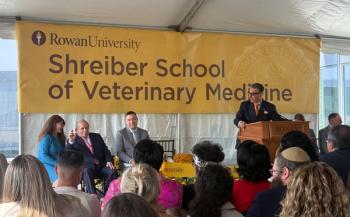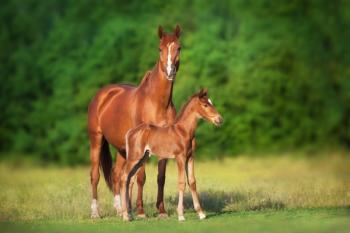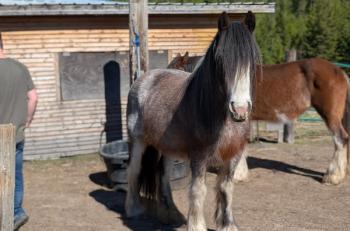
Equine influenza: What veterinarians must learn from the past
As researchers examine data from previous outbreaks, more insight is gained into reducing susceptibility to further epidemics.
"Those who cannot learn from history are doomed to repeat it." Philosopher George Santayana's famous quote reminds us to learn from the mistakes, failures, victories and successes of those who have come before us.
Fewer people, however, know that Santayana also said, "History is a pack of lies about events that never happened told by people who weren't there." That's the thing about history—some things are remembered, some quotes get repeated and immortalized, while some things are forgotten, and some words are unused and lost. What we eventually learn depends on the differences therein.
Any discussion of equine influenza must eventually become a conversation about its history since past outbreaks and attempts at management have helped teach us much of what we know about this disease.
The culprit
Equine influenza, an orthomyxovirus, is considered one of the most common infectious diseases of the respiratory tract in horses, and it is endemic throughout much of the world, with the notable exceptions of New Zealand and Ireland. It has been recognized in horses for centuries, and the history of the horse (and humankind) contains many notable epizootics, from the crippling outbreak in the United States and Canada in 1872 that paralyzed a horse-powered economy and affected nearly 90 percent of all horses in the country, to a more recent outbreak this past May in France that impacted the Fédération Équestre Internationale (FEI) 2012 Nations Cup show-jumping event.
Ideal conditions for disease spread
Equine influenza is highly contagious and spreads rapidly through groups of horses in aerosolized particles dispersed by coughing and sneezing. The highest risk for infection and most confirmed outbreaks center on situations in which large numbers of potentially stressed animals are in close contact. Horse shows and events combine the significant stressors of transport and competition and are, therefore, the situations most likely to result in infections.
Previously, it had been reported that the maximal distance for aerosolization in the horse (maximum coughing or sneezing distance) was 28 feet, so all horses within this distance from an infected horse potentially were at risk. But newer research from the 2007 influenza outbreak in Australia suggests weather factors may increase the range of potential infection.1
The researchers used information from the nearly 70,000 affected horses on more than 9,000 premises in this outbreak to determine whether specific conditions of humidity, temperature, rainfall and wind velocity could significantly influence the spread of equine influenza.1 They concluded that infection risk was decreased when the relative humidity was above 60 percent, on days when the maximum air temperature was 68 to 77 F (20 to 25 C) and when winds were less than 18.6 mph.
The researchers stated, "The interplay of meteorological factors during an actual influenza outbreak is less clear, and research into the contribution of weather to epidemic spread is scarce.... The relationships described [in our work] are of direct importance for managing disease risk during influenza outbreaks in horses, and more generally, advance our understanding of the transmission of influenza A virus under field conditions."1
Signs of disease
Horses infected with influenza virus have an incubation period of one to five days and may show mild to severe signs that include:
- Serous to mucopurulent nasal discharge
- A dry, hacking cough
- An increased temperature (102 to 105 F [38.8 to 40.5 C])
- Lethargy
- Depression
- Muscle soreness
- Enlarged regional lymph nodes
- Reluctance to eat or drink
These signs may last five to 10 days, and most affected horses recover in two to three weeks. Mortality ranges from 1 to 2 percent; since so many horses can potentially be affected in an outbreak, this number can be significant. Even though veterinary medicine was in its infancy and little was known about disease transmission or flu treatment at the time, it is worth noting that in the 1872 epizootic, the city of Philadelphia alone reported the loss of 2,500 horses, and a newspaper report from Farmingdale, N.Y., reported that 10 percent of all the heavy horses used in that city had died.
Outbreaks
Although influenza is endemic in many countries and continually circulates throughout the equine population, it has consistently been responsible for periodic explosive outbreaks throughout the globe and throughout history, frequently with devastating consequences. Most of these outbreaks are in populations with lower to no previous immunity (unvaccinated) or are associated with sufficient antigenic drift that allows the virus to evade vaccine immunity. (Antigenic drift refers to the fact that influenza virus continually modifies its protein structure and changes itself so as to increase its infectivity. Vaccines made against one particular strain of virus become less effective against a modified newer strain.)
While the drift of equine influenza is slower than that of human influenza, it's recommended that equine vaccines contain killed viral antigens from flu isolates obtained within the most recent five years.
Many horse owners have started questioning the frequency of vaccinations, and holistic-oriented websites promote fewer vaccines at less-frequent intervals. While, in general, the idea of reducing unnecessary vaccinations and the resulting stress to a horse's immune system is a reasonable goal, history teaches that reducing vaccination for equine influenza is likely to result in serious problems. Because of the particular characteristics of the virus and the historical lessons learned from past epidemics, current recommendations are to vaccinate horses for flu every six months. The FEI has required this vaccination frequency since 2005, and influenza is the only vaccine specifically required by that organization. Yet, with all that has been learned and all the precautions and regulations in place, problems have still cropped up.
In 1992, an influenza outbreak occurred among horses stabled at the Royal Hong Kong Jockey Club. This outbreak was important because Hong Kong requires all racehorses to be vaccinated against equine influenza and because there had been no cases of influenza reported since 1972. Still, this virus broke through what had been considered good quarantine protocol and vaccine protection. Nearly 1,500 horses were affected (37 percent of all horses within the outbreak zone). The most seriously affected were from countries where the disease did not naturally occur. Researchers investigating this outbreak concluded that while vaccination did not prevent influenza, the disease in vaccinated horses was less severe, and the signs lasted a shorter period then when horses were unvaccinated.
Flu-like signs were discovered in 16 horses stabled in Sydney, Australia, in August 2007. Much of the country eventually was involved, and the agricultural minister called the outbreak, "the biggest risk ever faced by the Australian Thoroughbred industry." It is thought the virus was brought into the country by a stallion shipped there from Japan for the breeding season. Australia leads the world in the number of racetracks and race clubs, and its nearly $7.7 billion racing industry employs 204,000 people. This robust section of the nation's economy was put in serious jeopardy by equine influenza virus.
Controlling and preventing further outbreaks
Identification of infected horses and isolation are the best methods of dealing with an outbreak. This "know and don't go" policy has stimulated many equine groups and organizations to implement or improve their information and warning programs so horse owners can be made aware of potential outbreaks and avoid travel to certain locales or equine events.
Last June, Merial launched an Equine Outbreak Alert Program aimed at providing just this sort of information to owners, who could then adjust their show or travel plans to avoid potential problem areas.
The May influenza outbreak involving more than 200 horses within a 20-mile radius in the Normandy region of France should remind us that equine influenza remains a persistent threat to the global equine community. The affected horses in this area had all been vaccinated, and no specific cause has been found for the introduction of the disease. Researchers will be looking at horse movement, weather, antigenic variability and all the other factors that they have learned that impact influenza infection in horses.
When it comes to this disease, the most appropriate statement from history may be one from former Chancellor of Germany Konrad Adenauer: "History is the sum total of things that could have been avoided." Using appropriate influenza vaccines on good, repeatable schedules; monitoring horse movement; maintaining quarantine measures; and continually learning from what happened before will not stop influenza outbreaks. But even if we cannot avoid infections, we may be able to reduce their extent and severity, which is a good start for the future.
Dr. Kenneth Marcella is an equine practitioner in Canton, Ga.
Reference
1. Firestone SM, Cogger N, Ward MP, et al. The influence of meteorology on the spread of influenza: survival analysis of an equine influenza (A/H3N8) outbreak. PLoS ONE 7(4):e5284.
Newsletter
From exam room tips to practice management insights, get trusted veterinary news delivered straight to your inbox—subscribe to dvm360.






